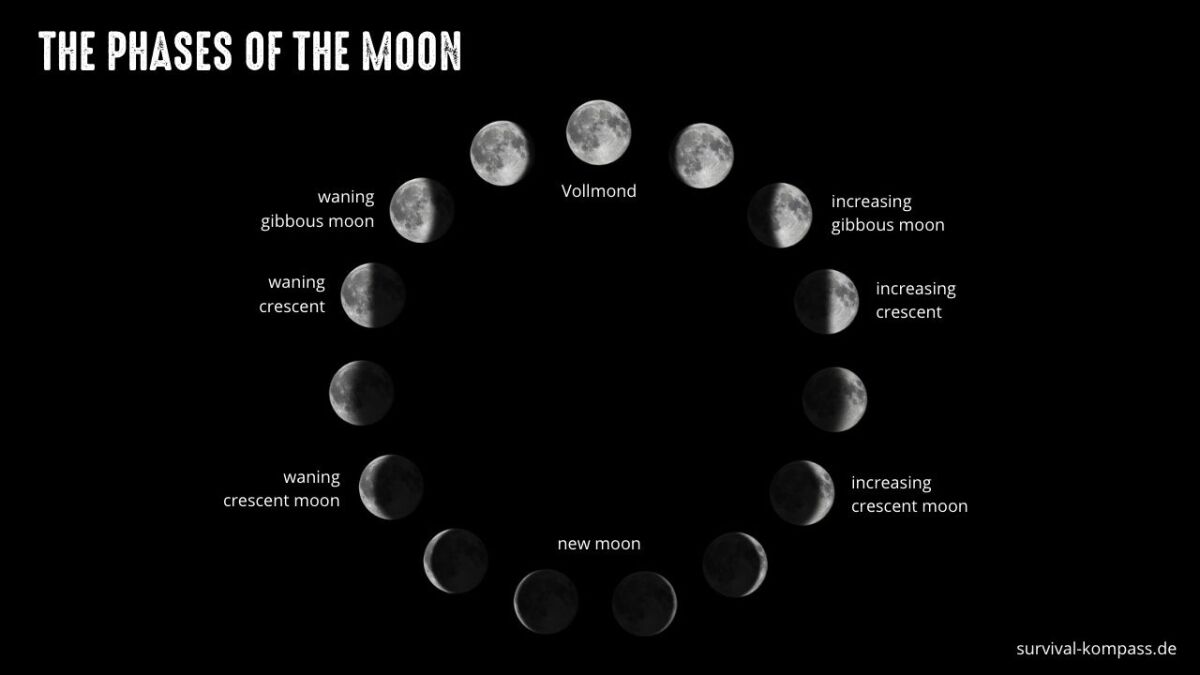
Orientation moon
Nomen
Meaning
Orientation moon refers to the practice of using the moon as a navigational tool in outdoor activities such as survival, bushcraft, camping, hiking, and wilderness exploration. It involves observing the moon's position, phase, and movement to determine direction, time, and location. The moon's predictable patterns can help adventurers find their way, especially when other navigational tools like compasses or GPS devices are unavailable or unreliable. Understanding orientation moon is essential for outdoor enthusiasts as it allows them to navigate through unfamiliar terrain, plan their journeys, and stay on track, ensuring a safe and successful outdoor experience.

Examples
„I love using the orientation moon to navigate in the wilderness at night. It's a great way to find my bearings and stay on track.“
„During our survival training, my instructor taught us how to use the orientation moon to determine our direction when we were lost. It was a valuable skill to have in case of emergencies.“
„When I go camping, I always make sure to check the orientation moon before setting up my tent. It helps me position it in a way that I can enjoy the best views and avoid any potential hazards.“
„My friend and I were hiking in the mountains when we got caught in a sudden fog. Thankfully, we had our compass and the orientation moon to guide us back to the trail.“
„As a bushcraft enthusiast, I often rely on the orientation moon to plan my outdoor activities. It helps me schedule my trips and make the most of the natural light available.“
Origin
The word "orientation" comes from the Latin word "orientare," which means "to face the east." This is because the east is where the sun rises, and it has long been used as a point of reference for navigation and direction. The concept of orientation has its roots in ancient civilizations, where people would use the position of the sun, stars, and landmarks to find their way.
In terms of survival and outdoor skills, orientation is crucial for finding your way in unfamiliar terrain. It involves understanding your surroundings, knowing how to read a map and compass, and being able to navigate using natural indicators such as the position of the sun and moon.
The moon, in particular, has played a significant role in orientation throughout history. Its phases and position in the sky can provide valuable information about time, direction, and even weather patterns. For example, the moon's position relative to the horizon can help determine the cardinal directions, with the moon rising in the east and setting in the west.
When it comes to survival, being able to orient yourself using the moon can be a useful skill. By observing the moon's position and phase, you can estimate the time of day or night, navigate in low-light conditions, and even predict tides or weather changes.
Overall, orientation is a fundamental skill for anyone venturing into the wilderness. Understanding the origins of the word and its connection to celestial bodies like the moon can deepen your appreciation for the importance of navigation and direction in survival situations.
Synonyms
Navigation, Direction finding, Celestial navigation, Orienteering, Map reading, Compass navigation, Wayfinding, Land navigation
Antonyms
Sun, Daylight, Direction, Compass, Map, Guide, Navigation, Knowledge
Relatives
Navigation, Compass, Stars, Celestial navigation, Map reading, Orienteering, Direction, Night sky
Historical and cultural importance
The orientation moon is a term used in bushcraft and survival to refer to the moon's position in the sky, which can be used as a navigational tool. Throughout history, various cultures have recognized the significance of the moon in determining direction and time.
For centuries, sailors have relied on the moon's position to navigate the seas, using its phases and position to determine their location and direction. In many indigenous cultures, the moon has been revered as a celestial guide, with its movements and phases serving as important markers for hunting, planting, and other activities.
In bushcraft and survival, understanding the orientation moon can be crucial for finding your way in the wilderness. By observing the moon's position in relation to the horizon, you can determine the cardinal directions, even without a compass. For example, when the moon rises in the east, it indicates that you are facing west.
Additionally, the moon's phases can also provide valuable information for survival. A full moon can illuminate the surroundings, making it easier to navigate at night, while a new moon can create darker conditions. By understanding the moon's phases and their impact on visibility, you can plan your activities accordingly.
Overall, the historical and cultural significance of the orientation moon highlights its importance as a navigational tool in the wild. By paying attention to the moon's position and phases, you can enhance your survival skills and better navigate your way through the wilderness.
More information about the term Orientation moon
Orientation Moon
When it comes to survival in the wilderness, having a good sense of direction is crucial. One of the most reliable tools for navigation is the moon. The moon's position and phases can provide valuable information to help you find your way. In this section, we will explore how to use the moon for orientation in the wild.
Understanding Moon Phases
The moon goes through different phases throughout the month, and each phase can give you important clues about your location and the time of day. The four primary moon phases are:
- New Moon: During this phase, the moon is not visible in the sky.
- First Quarter: The moon appears as a half-circle.
- Full Moon: The entire face of the moon is visible.
- Last Quarter: The moon appears as another half-circle, but the opposite side is illuminated.
By observing the moon's phase, you can determine the approximate time of night and the direction you are facing.
Using the Moon as a Compass
When the moon is visible, it can act as a natural compass, especially during the night. Here are a few tips on how to use the moon for orientation:
- Identify the moon's phase: By knowing the moon's phase, you can estimate the time and direction.
- Locate the moon: Look for the moon in the sky and determine its position relative to the horizon.
- Find east and west: If the moon is rising, it is generally in the east. If it is setting, it is generally in the west.
- Use the moon as a reference point: Once you know the moon's position, you can use it as a reference point to navigate.
Remember that the moon's position will change throughout the night, so it's essential to periodically check its location to stay on track.
Additional Tips for Navigation
While the moon can be a reliable tool for orientation, it's always wise to have multiple methods at your disposal. Here are a few additional tips for navigation in the wilderness:
- Learn to read a compass: A compass is a valuable tool for precise navigation.
- Study the stars: Familiarize yourself with the constellations to find your way at night.
- Pay attention to landmarks: Take note of distinctive features in the landscape to help you navigate.
- Practice map reading: Improve your map reading skills to plan routes and identify key landmarks.
By combining different navigation techniques, including using the moon as a compass, you can significantly increase your chances of finding your way in the wild.
Remember, survival is all about preparation and knowledge. The more you understand about your surroundings and the tools available to you, the better equipped you will be to navigate and thrive in the wilderness.
Back to overview

